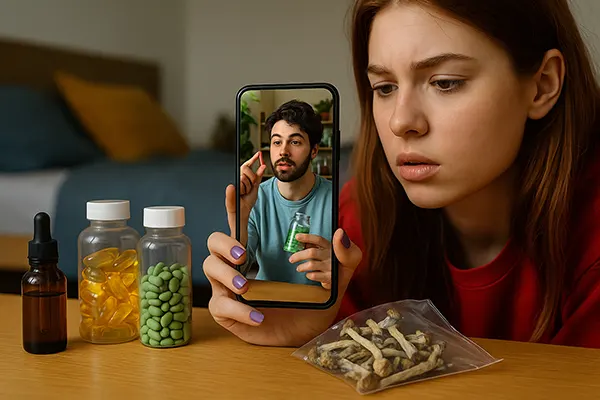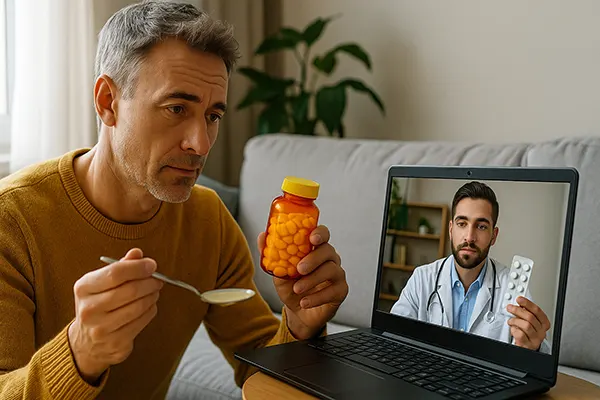
New TikTok Trend 2025: Unverified Biohacking Tips and the Health Risks for Young People
In early 2025, TikTok feeds are flooded with self-proclaimed health gurus promoting so-called “biohacking” tips. These short, engaging videos offer everything from dangerous microdosing protocols to extreme fasting and DIY supplement stacks. While the trend appeals to a generation obsessed with self-optimisation, it also raises red flags among medical professionals and parents alike.
Why Biohacking Videos Are Going Viral Among Teens
The format of TikTok – short, catchy, and visually stimulating – is perfectly suited for rapid spread of wellness trends. Many influencers promise quick fixes for better focus, sleep, or weight loss without any medical backing. Their confident tone and appealing visuals often disguise the fact that their recommendations are based on personal anecdotes or pseudo-science. Algorithms reward engagement, not accuracy, further fuelling the popularity of such content.
In a hyper-competitive digital world, teens increasingly turn to self-improvement content to manage academic pressure and social stress. The promise of gaining an edge through “natural hacks” is tempting. Videos with hashtags like #dopaminefast, #microdosing or #biohacklife receive millions of views, often portraying these methods as safe shortcuts to success. Unfortunately, this creates a false perception of safety and normalcy.
Compounding the problem is the influencer economy itself. Some content creators have financial incentives to push questionable supplements or promote affiliate links. As a result, teenagers are not only exposed to misleading information but are actively encouraged to spend money on unregulated substances with potentially harmful effects.
The Role of TikTok’s Algorithm in Spreading Misinformation
TikTok’s recommendation engine is designed to maximise user engagement, not verify medical accuracy. Once a user interacts with wellness-related content, they are quickly bombarded with similar videos – regardless of whether the advice is medically sound. This echo chamber effect can distort a young person’s understanding of health and normalise risky behaviours.
Moreover, videos flagged for misinformation are often not removed fast enough. Although TikTok has implemented some content moderation policies, enforcement remains inconsistent. In several documented cases, it took days or even weeks before dangerous content was taken down, during which it had already gone viral and influenced thousands of viewers.
Another loophole lies in the way creators phrase their content. By using vague language like “this helped me” or “just sharing my routine,” they avoid making direct health claims that might trigger moderation. This allows dubious advice to bypass automated filters, leaving users exposed to unchecked information.
Real-Life Consequences of Following Unverified Advice
Medical reports from February 2025 confirm several cases of hospitalisation due to improper use of supplements promoted on TikTok. One notable incident in Germany involved a 16-year-old who followed a DIY detox protocol and suffered liver damage. In the United States, emergency rooms have reported a rise in adverse reactions linked to unprescribed nootropics bought online after being featured in viral videos.
Nutritionists also warn about the impact of extreme diets trending under hashtags like #carnivorecleanse or #30dayfast. These restrictive regimens, often presented without any professional guidance, can lead to malnutrition, hormonal imbalances, or eating disorders. Young viewers, already vulnerable to body image pressures, are especially at risk of copying such behaviours without understanding the long-term effects.
Psychological consequences are also emerging. Obsession with productivity and self-optimisation has been linked to anxiety, burnout, and social withdrawal among teens. Many adolescents report feeling inadequate or “lazy” for not adopting these biohacks, despite leading healthy, balanced lives. The pressure to constantly optimise one’s body and brain can undermine mental well-being rather than enhance it.
What Can Parents and Schools Do?
Open communication remains one of the most effective tools for prevention. Parents and educators should create safe spaces for dialogue about health trends on social media. Instead of banning apps outright, adults can guide teenagers in developing critical thinking skills and media literacy. Encouraging teens to verify sources and consult professionals before trying health-related advice is key.
Schools can incorporate digital literacy and health education into their curricula to address the unique challenges posed by online wellness culture. By analysing real TikTok examples in the classroom, students learn to differentiate between credible and misleading content. Collaboration between teachers, health professionals, and tech platforms can amplify these efforts.
Additionally, reporting dangerous content and promoting verified sources is crucial. Campaigns supported by health ministries or NGOs, featuring trusted experts on platforms like TikTok and YouTube, can help balance the narrative. When teens see relatable, science-based creators promoting safety, they are more likely to question harmful trends.

Is TikTok Doing Enough to Protect Young Users?
While TikTok has taken steps to address misinformation – such as tagging certain videos with disclaimers or redirecting searches to official sources – enforcement remains inconsistent. The sheer volume of content makes manual review difficult, and AI moderation struggles with nuance, sarcasm, or coded language used to bypass filters.
Experts argue that the platform should prioritise investment in health-specific moderation teams and improve transparency in enforcement policies. TikTok’s current approach relies heavily on user reports, which may come too late. Proactive scanning for keywords or hashtags associated with risky behaviours could offer better protection for young users.
Furthermore, collaboration with public health organisations needs to be more visible. While partnerships exist, they rarely appear in the main feed or influencer collaborations – the spaces where teens spend most of their time. Embedding verified health messages within popular content formats, such as duets or trends, may prove more effective than traditional warnings or redirects.
The Future of Online Wellness Culture
Biohacking itself is not inherently harmful; in fact, some techniques like sleep tracking or mindfulness practices have proven benefits. The challenge lies in distinguishing evidence-based methods from dangerous shortcuts. Without proper regulation and education, TikTok risks becoming a breeding ground for health myths with real-world consequences.
As wellness continues to intersect with digital content creation, platforms must take a more active role in shaping safe, informed communities. Transparent policies, meaningful moderation, and promotion of expert voices are essential for progress. Technology has the power to empower – or endanger – depending on how responsibly it is managed.
Ultimately, protecting young minds from misinformation requires a collective effort. Social platforms, educators, families, and health professionals must all work together to build a culture of curiosity, safety, and critical awareness. Only then can the digital wellness revolution truly benefit those it intends to help.
